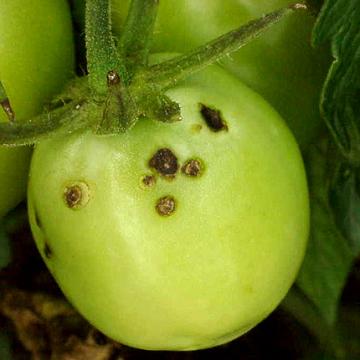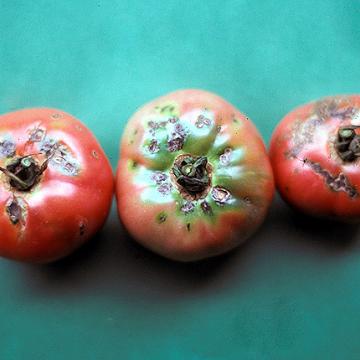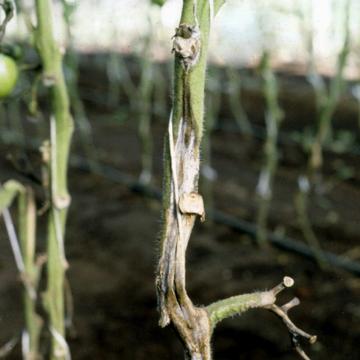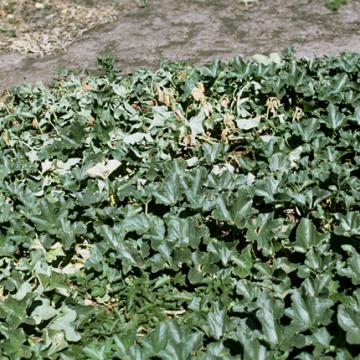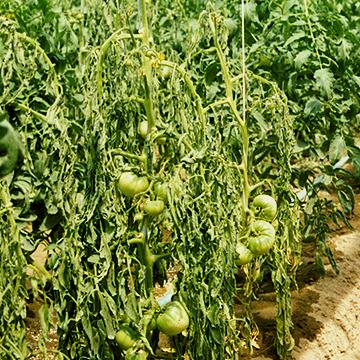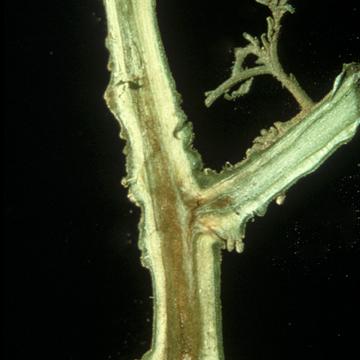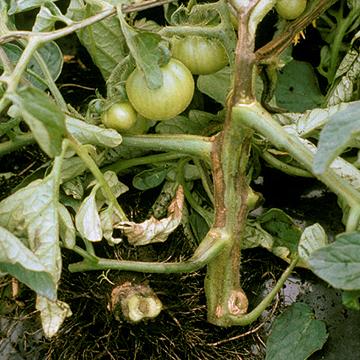DISEASE: Bacterial spot
HOST: Tomato
Green fruit with dark brown lesions. The bacterial spot xanthomonads are Xanthomonas euvesicatoria, X. vesicatoria, X. perforans, and X. gardneri. X. perforans is not known to infect fruit.
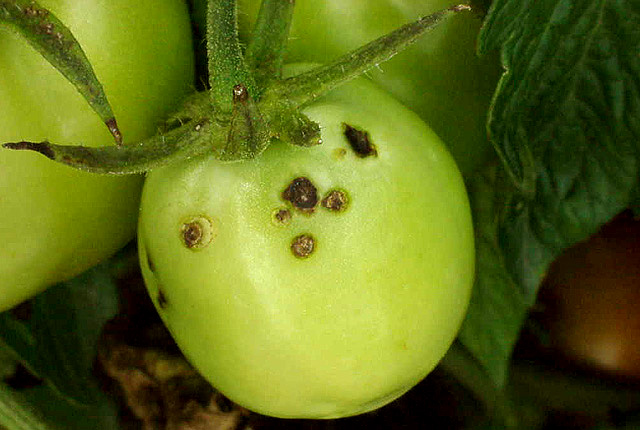
Bacterial spot | Tomato
DISEASE: Bacterial spot
HOST: Tomato (Lycopersicon esculentum)
PATHOGEN: Xanthomonas bacterial spot pathogens
PATHOGEN SYNONYM: Xanthomonas axonopodis pv. vesicatoria
SOURCE: S. Miller
DISEASE: Bacterial spot
HOST: Tomato
Ripe fruit with dark brown spots. The bacterial spot xanthomonads are Xanthomonas euvesicatoria, X. vesicatoria, X. perforans, and X. gardneri. X. perforans is not known to infect fruit.
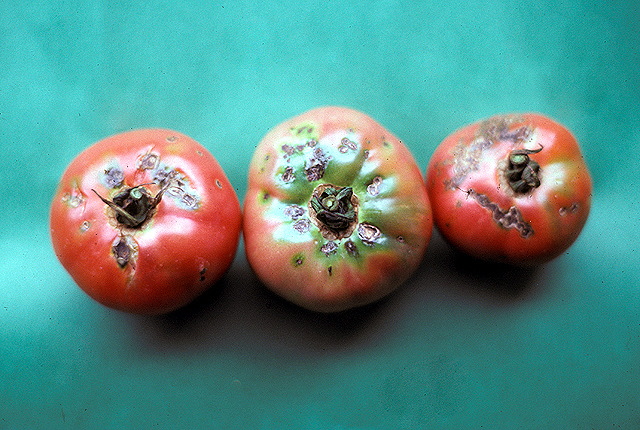
Bacterial spot | Tomato
DISEASE: Bacterial spot
HOST: Tomato (Lycopersicon esculentum)
PATHOGEN: Xanthomonas bacterial spot pathogens
PATHOGEN SYNONYM: Xanthomonas axonopodis pv. vesicatoria
SOURCE: M. Goto
DISEASE: Bacterial stem rot
HOST: Tomato
Stem with long necrotic lesions. The pathogen often enters plants following pruning injuries.
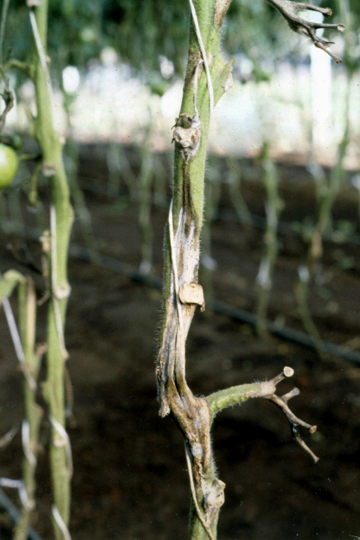
Bacterial stem rot | Tomato
DISEASE: Bacterial stem rot
HOST: Tomato (Lycopersicon esculentum)
PATHOGEN: Pectobacterium atrosepticum
PATHOGEN SYNONYM: Ewinia carotovora subsp. atroseptica
SOURCE: A. Alvarez
DISEASE: Bacterial stem rot
HOST: Tomato
Wilt is first symptom of disease. Later, the pith usually disintegrates, causing hollow and blackened stems.
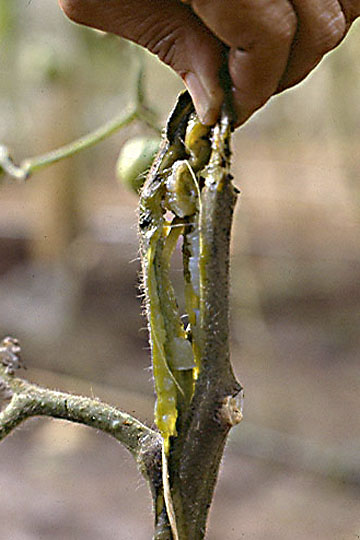
Bacterial stem rot | Tomato
DISEASE: Bacterial stem rot
HOST: Tomato (Lycopersicon esculentum)
PATHOGEN: Pectobacterium atrosepticum
PATHOGEN SYNONYM: Erwinia carotovora subsp. atroseptica
SOURCE: M. Stanghelllini
DISEASE: Bacterial wilt
HOST: Cantaloupe
Cantaloupe field with severe destruction from bacterial wilt (left), less on right.
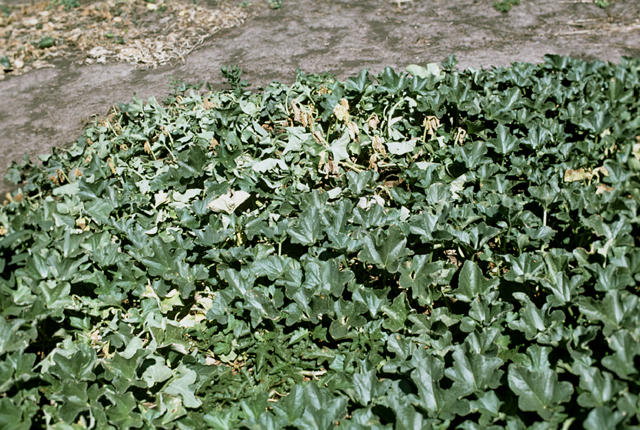
Bacterial wilt | Cantaloupe
DISEASE: Bacterial wilt
HOST: Cantaloupe (Cucumis melo var. cantalupensis)
PATHOGEN: Erwinia tracheiphila
SOURCE: L. Claflin
DISEASE: Bacterial wilt
HOST: Tomato
Severely infected plants in glass house. First symptoms appear as wilt of young leaves. Leaf epinasty may occur.
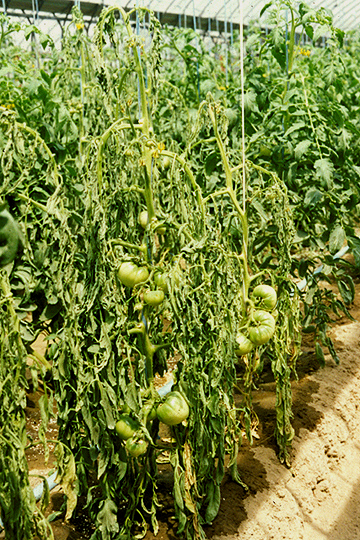
Bacterial wilt | Tomato
DISEASE: Bacterial wilt
HOST: Tomato (Lycopersicon esculentum)
PATHOGEN: Ralstonia solanacearum
PATHOGEN SYNONYM: Pseudomonas solanacearum
SOURCE: M. Goto
DISEASE: Bacterial wilt
HOST: Tomato
Necrotic, brownish, cortical tissues. Massive infection of cortex may result in water-soaked lesions on stem surfaces.
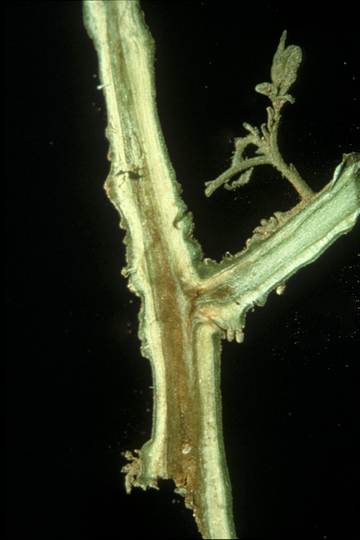
Bacterial wilt | Tomato
DISEASE: Bacterial wilt
HOST: Tomato (Lycopersicon esculentum)
PATHOGEN: Ralstonia solanacearum
PATHOGEN SYNONYM: Pseudomonas solanacearum
SOURCE: A. Hayward
DISEASE: Pith necrosis
HOST: Tomato
Cracked, dry, hollow stems with internal necrosis.
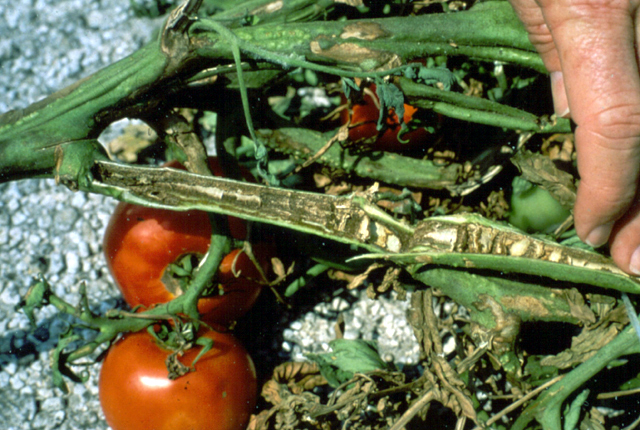
Pith necrosis | Tomato
DISEASE: Pith necrosis
HOST: Tomato (Lycopersicon esculentum)
PATHOGEN: Pseudomonas corrugata
SOURCE: A. Alvarez
DISEASE: Pith necrosis
HOST: Tomato
External necrotic stem tissues. Initial symptoms include chlorosis of young leaves. Wilting may occur when disease is severe.
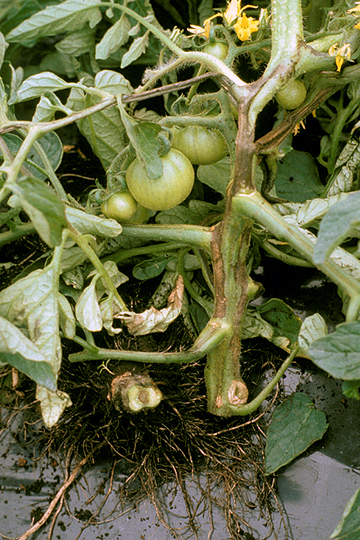
Pith necrosis | Tomato
DISEASE: Pith necrosis
HOST: Tomato (Lycopersicon esculentum)
PATHOGEN: Pseudomonas corrugata
SOURCE: K. Natsuaki, M. Goto


